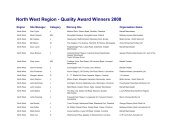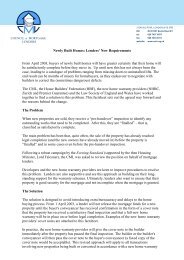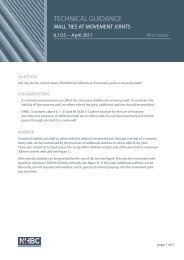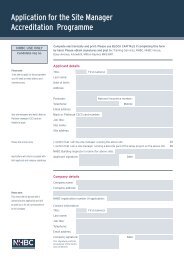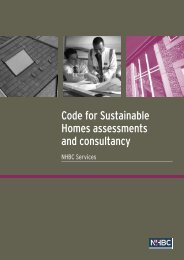June 2010 - NHBC Home
June 2010 - NHBC Home
June 2010 - NHBC Home
You also want an ePaper? Increase the reach of your titles
YUMPU automatically turns print PDFs into web optimized ePapers that Google loves.
Sustainability<br />
Extra<br />
<strong>NHBC</strong> Foundation<br />
Set up in 2006, the <strong>NHBC</strong> Foundation has now completed 25 projects, outputs from<br />
which are published on its website at www.<strong>NHBC</strong>Foundation.org. The latest two<br />
reports improve our understanding of the efficient use of piled foundations and<br />
consider how the performance of drainage systems may be affected if, in future,<br />
the volume of water used to flush WCs is further reduced.<br />
Efficient design of<br />
piled foundations for<br />
low-rise housing:<br />
Design guide<br />
Amongst the benefits of<br />
using piled foundations are<br />
a range of environmental<br />
advantages that may help<br />
achieve compliance with<br />
the Code for Sustainable <strong>Home</strong>s.<br />
Although the advantages will depend upon the<br />
particular development site and the type of piling<br />
selected, they can include:<br />
• reduced waste arisings and less waste to landfill<br />
• reduced neighbour nuisance – vibration, noise and<br />
air quality<br />
• reduced embodied carbon dioxide emissions due<br />
to the reduced volume of concrete used.<br />
In addition to these potential advantages, it is<br />
sometimes even possible for the collector loop of a<br />
ground source heat pump to be enclosed within piles.<br />
This <strong>NHBC</strong> Foundation report, prepared with support<br />
from Arup, considers these environmental aspects<br />
alongside other key considerations relating to the<br />
selection and efficient design of piled foundations.<br />
This project undertaken by WRc, with support from<br />
the Foundation and other research partners, studied<br />
the potential consequences of lower flush volumes on<br />
the performance of drainage systems. Test rigs were<br />
used to identify the how far various solids would travel<br />
along a drainage system before coming to a halt as the<br />
amount of water used for flushing was reduced.<br />
The principal finding of the project was that the<br />
current combination of typical flush volumes<br />
together with typical drainage system layouts does<br />
provide satisfactory performance. However, if the<br />
flush volume is reduced and/or the length of the<br />
drain is increased, performance is reduced and<br />
could potentially become unsatisfactory, leading<br />
to increased problems with blockages. This project<br />
provides useful data, which will be used to inform<br />
further debate on related standards and regulations.<br />
‘Pull the chain, fill<br />
the drain’<br />
Improvements to the water<br />
efficiency of new homes are<br />
increasingly being driven by<br />
the Code for Sustainable<br />
<strong>Home</strong>s and also (in England<br />
and Wales) through Part G<br />
of the Building Regulations.<br />
One key component of<br />
domestic water consumption<br />
is that used for flushing WCs, and significant<br />
quantities of water can be saved by specifying WCs<br />
with lower flush volumes.<br />
The drainage test rig<br />
5




